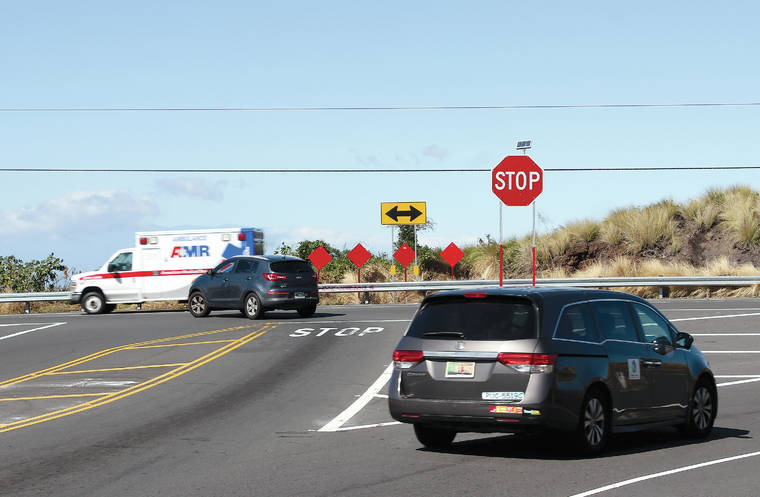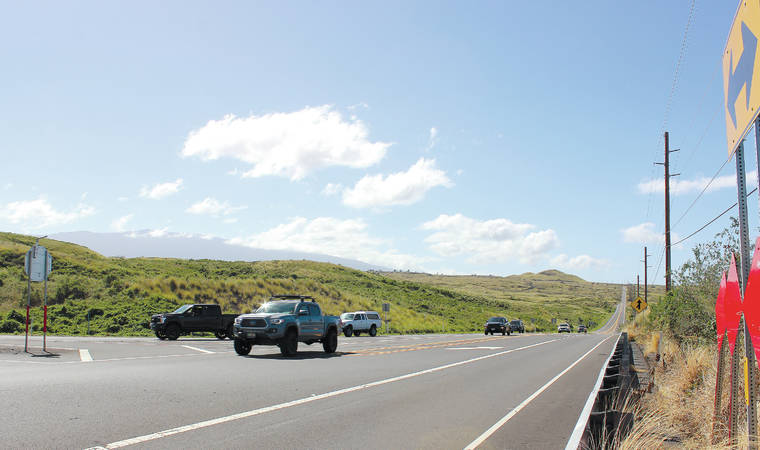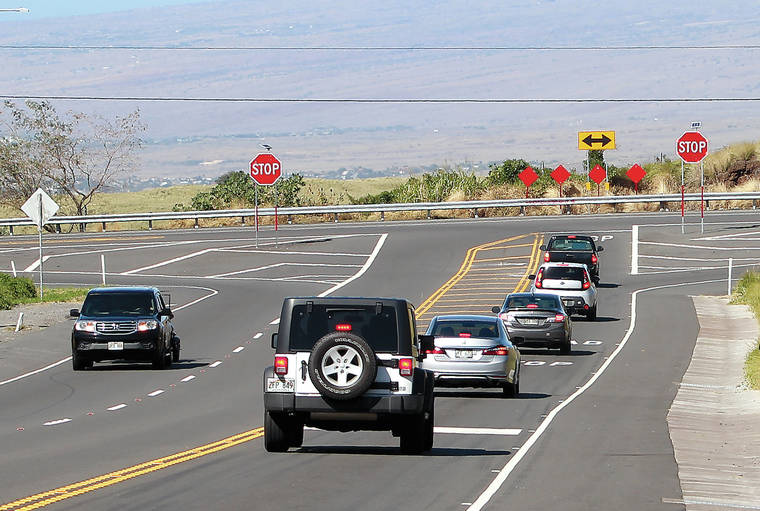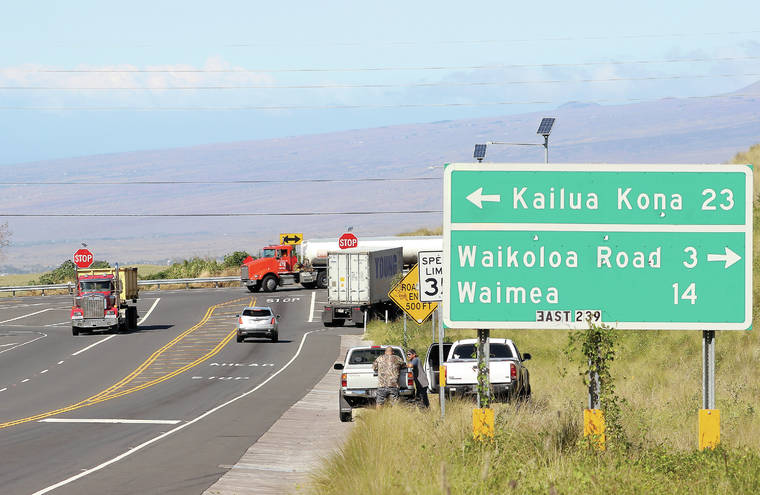$90M penciled in for Saddle extension




The busy terminus of Daniel K. Inouye Highway at Mamalahoa Highway, also known Highway 190, is seen Dec. 17. (Chelsea Jensen/West Hawaii Today)
KAILUA-KONA State transportation officials are targeting a new source of funding to help cover some of the cost of extending Daniel K. Inouye Highway to Queen Kaahumanu Highway.
KAILUA-KONA — State transportation officials are targeting a new source of funding to help cover some of the cost of extending Daniel K. Inouye Highway to Queen Kaahumanu Highway.
The Department of Transportation has requested $90 million in special funds and revenue bonds via Gov. David Ige’s supplemental executive budget released on Dec. 16, to finish environmental work, acquire land and construct the road, known colloquially as the Saddle Road Extension, from its current terminus at Mamalahoa Highway in South Kohala.
ADVERTISING
The budget will be submitted to the upcoming Legislature, which will determine whether funding is allocated for fiscal year 2021.
“We are seeking this appropriation through the supplemental budget as the project is a candidate for the new funding anticipated from the rental car surcharge approved by the State Legislature in 2018,” said DOT spokeswoman Shelly Kunishige.
The surcharge increase, which was signed into law by Ige, went into effect on Jan. 1, 2019. It increased the per-day surcharge from $3 to $5 for rentals to drivers without a Hawaii driver’s license with funds going to the county in which the rental motor vehicle was driven.
“I know how important this highway is to our communities on Hawaii Island, and we believe the extension will help our businesses and contribute to a better quality of life for our residents. In addition, capital projects such as this have broad economic impacts and support jobs in the construction industry,” Ige said Friday.
The $90 million figure is based on the most recent estimate for the project, which has remained in the environmental review phase since the release of a draft Environmental Impact Statement for the project in April 2017. Kunishige said the department is currently budgeting $5 million for right-of-way acquisition and $85 million for construction of the approximately 10.5-mile road.
According to Ige’s supplemental budget, the $85 million will be funded via revenue bond with the remaining $5 million derived from the special fund, which is cash from the State Highway Fund. Revenue bonds allow the state to borrow on anticipated revenue so the department can fund larger projects.
“While safety and system preservation are always HDOT’s priority, we are taking steps necessary to prepare capacity projects such as the Saddle Road Extension should funds become available,” Kunishige said. “These steps include appropriation of funds, inclusion on the Statewide Transportation Improvement Program, and completion of the environmental process.”
Currently, the department is planning to utilize state funds only, though the project remains eligible for federal funding that would cover up to 80% of the cost. It did not receive funding via a 2019 BUILD Discretionary Grant, though an elevated pedestrian walkway in Honolulu was allocated $20 million. No Hawaii projects were funded in 2018.
“The project is on the STIP so it would be eligible for federal funding if it becomes available,” Kunishige said. The STIP, or Statewide Transportation Improvement Projects list, is a multi-year listing of state and county project that identifies projects slated for federal funding.
The extension is still working its way through the Section 106 consultation with State Historic Preservation Division, which must be completed before the Federal Highway Administration can sign off on the draft EIS allowing the project to move forward.
“Once completed, and a funding source is committed, the Record of Decision can be issued, completing the NEPA process,” according to Project Manager Mike Will with the Federal Highway Administration’s Central Federal Lands Highway Division. “Depending on the timeline for construction funding, project development activities will then begin in preparation of construction contract documents, supporting solicitation for the future construction contract award.”
The DLNR, under which the State Historic Preservation Division falls, reported Thursday that “discussions are ongoing” more than 32 months after the draft EIS was released.
According to the EIS, the approximate 10.5-mile extension is expected to take about two years to construct once work is underway. In 2017, project’s anticipated cost ranged from $63 million to $74 million, depending on which alignment was selected, with project completion scheduled in 2020.
One option would have the road approximately follow the boundary between the North Kona and South Kohala districts. The others would take the road farther north and connect to Waikoloa Road close to mile marker 3, with the third option also using 2 miles of Waikoloa Road west of that mile marker.
As of this month, the state had listed $90 million as the anticipated project cost — an increase of 42.9% and 21.6%, respectively, over the 2017 price estimates. A current projected start date was not provided by the Department of Transportation.
“The project schedule will be set once the FEIS is published,” Kunishige said.
Saddle Road, most of which was renamed Daniel K. Inouye Highway post-modernization and western realignment, was originally built in 1942 as a one-lane road to connect military training facilities. For years, the county maintained the state-owned roadway until the 1980s when a push for the state to take responsibility began, according to West Hawaii Today archives and previous environmental studies conducted for the roadway.
The effort to modernize Saddle Road from Mamalahoa Highway to Hilo dates to February 1991, when an interagency scoping meeting was held in Honolulu to discuss improvements of the roadway within PTA. By May 1994, public scoping meetings were held for the preparation of an EIS.
In October 1997, a draft EIS for the project was published with a final EIS released September 1999. That’s when an EIS for the extension began, though it was delayed for years due to uncertainty about the western terminus of the re-aligned Saddle Road that arose when the U.S. Army purchased for training the land the road was to cross, requiring a supplemental EIS that wasn’t completed until 2010.
In 2011, the EIS process for the extension was resumed, followed by the publication of a preparation notice in May 2012 and the draft’s release in April 2017.
Saddle Road has now been modernized or realigned for 48 miles between Hilo and its terminus a few miles south of Mamalahoa Highway’s intersection with Waikoloa Road. As of October 2017, state and federal agencies reported having spent $316.5 million on the project.
The road was named the Daniel K. Inouye Highway, in memory of the U.S. senator who championed the road improvement project, following the 2013 completion of the stretch of road between mile marker 42 and its terminus with Mamalahoa Highway.


